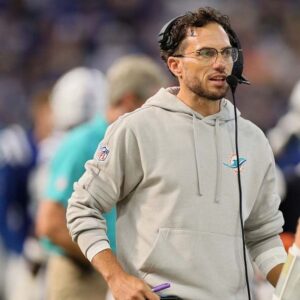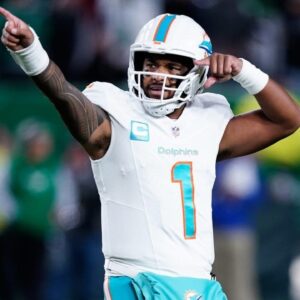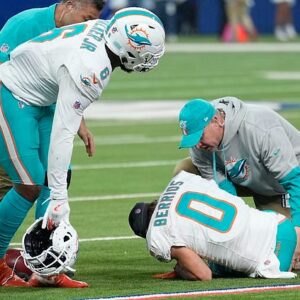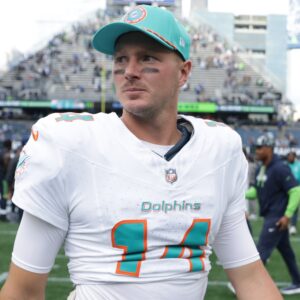Dolphins quarterback Tua Tagovailoa received encouraging feedback from a neurologist last week and is expected to play again this season, coach Mike McDaniel said for the first time Monday.
But McDaniel stopped short of saying Tagovailoa would definitely practice next week, when he’s eligible to come off injured reserve. He will seek additional medical input this week, McDaniel said.
“It’s exciting that I do believe he’ll play football this year,” McDaniel said, having previously declined to speculate on the matter.
What Tagovailoa is being told by neurologists “continues to be positive,” McDaniel said, while adding that “the process continues” with more meetings this week.
According to sources, Tagovailoa hasn’t had lingering symptoms since sustaining the concussion on Sept. 12 against Buffalo. That has fueled hopes that he could play Oct. 27 at home against Arizona, and that scenario remains in play.
That’s the first game that he’s eligible to play after missing the required four games while on injured reserve.
In the meantime, Tyler Huntley will start Sunday’s game at Indianapolis (1 p.m., Fox).
If Tagovailoa sustains another concussion this season, he’s unlikely to return to play in 2024, according to several concussion experts.
Those experts include 30-year neurosurgeon Lloyd Zucker, who works at Brain and Spine Center of South Florida and formerly held executive neurosurgery posts at Delray Medical Center and Good Samaritan Hospital in West Palm Beach.
If Tagovailoa sustains another concussion this season, Zucker said: “I would take him out for the remainder of this season. I’ve [been] seeing some young people go through what Tua has gone through and he would be [already be ruled] out for the season. Given the propensity he seems to have for it, the longer he rests before God forbid another concussion, the better off he’s going to be.”
Asked if he could envision any scenario where Tagovailoa could return to play quickly after a concussion next season or beyond, Zucker said: “I would discourage it because if the cause does not seem to be outwardly that major, not roughing the passer or thrown to the ground, I would look at past history and give it [extended] time.”
And if the hit is especially violent and causes a concussion, Zucker agreed that the absence likely would not be brief in that case, either, because “we are supposed to err on the side of protecting the patient… The more severe the impact, the more likely his rest period would be longer. Every concussion adds to to the potential of having future problems.”
Zucker’s colleague, Brain and Spine Center of South Florida managing partner and neurosurgeon Evan Packer, told the Miami Herald recently that an extended absence would follow any future Tagovailoa concussions and “the length of time would be greater and greater.”
Asked if Tagovailoa should return to play this season, Zucker said: “I would put him through a very strenuous activity program in terms of aerobics, weights, as much as I could to simulate the real game without a head impact to try and see if the rigors of the game itself would cause… any symptoms. If [they do], he’s iced for another six to eight weeks and then try over again.”
Tagovailoa hasn’t gone through the most rigorous parts of returning to play, but because he has not had symptoms, there’s optimism that he won’t have symptoms once he returns to practice.
The strenuous activities referenced by Zucker are part of the late stages of the NFL’s five-step concussion protocol. For a quarterback to advance to the final stages of concussion protocol, authorization is needed from a team doctor and an independent neurologist.
McDaniel has not offered an answer when asked what stage Tagovailoa has advanced to. But practicing with the team appears to be the next step.
Is there any data to show if players who have had multiple concussions, like Tagovailoa, are more prone to serious concussions in the future?
“I don’t know if there’s studies that have looked at that,” Zucker said. “Most neurosurgeons would look at him and say ‘you’ve shown you’re prone to concussions.’”
Packer said Tagovailoa appears more prone to concussions, in general, than the average person.
Another concern, noted by Zucker and others, is Tagovailoa “seems to be [concussed] from hits that other players in the same position have walked away from without concussions. Does that immediately translate to he’s more prone? It’s hard to know but seems to be that way now.”
In terms of determining how much damage Tagovailoa’s brain has sustained after multiple concussions, Zucker noted there is “some high end imaging that can look at tracks within the brain and show some very subtle changes. The trouble is this imaging is so new” that it’s impossible to determine a longterm prognosis.
But neurologists haven’t told Tagovailoa anything that would discourage him from playing this season, or at all.



